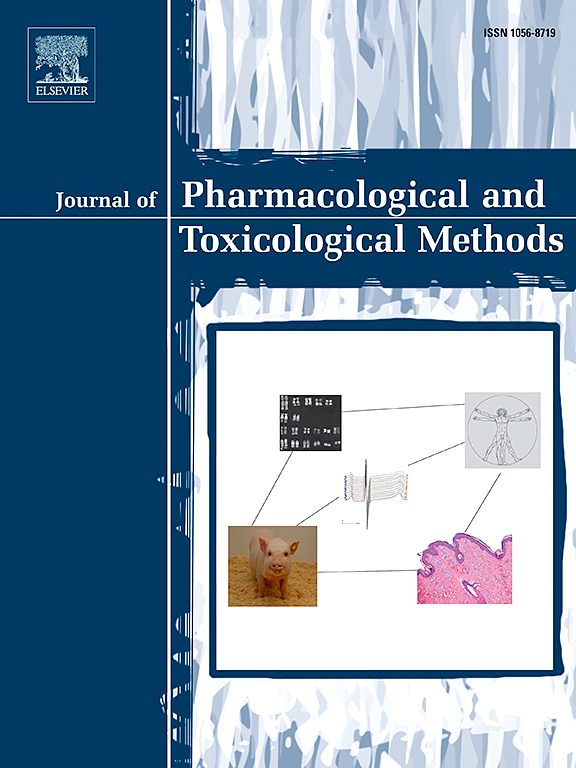Recommendations on the measurement of electrocardiogram and hemodynamic parameters in restrained non-rodent species in regulatory safety assessment studies
IF 1.3
4区 医学
Q4 PHARMACOLOGY & PHARMACY
Journal of pharmacological and toxicological methods
Pub Date : 2025-05-01
DOI:10.1016/j.vascn.2025.107601
引用次数: 0
Abstract
Life supportive cardiovascular (CV) parameters [e.g., arterial blood pressure (BP), electrocardiogram (ECG), heart rate (HR)] are recorded in non-rodent safety pharmacology and toxicology studies and data are used to support pharmaceutical drug development in accordance with several guidelines (e.g., ICH M3, S6, S7, S9). Various methodological approaches are used to collect CV parameters on toxicology studies, including fully implantable telemetry, non-invasive jacket telemetry, and short-duration restraint-based measurement from surface ECG leads and a blood pressure cuff, but their robustness and applicability domain differ widely. The challenge of using conscious animals, especially non-human primates, is that arousal behavior, locomotion, body temperature, and sympathetic activation are significant sources of variability that impact CV parameters, thus telemetry methods are the preferred approach. Historically, toxicology studies have incorporated short-duration restraint methods (manual; chemical sedation) to collect brief periods (“a snapshot at one timepoint”) of CV endpoints in a large number of non-rodents (N ≥ 24) after repeat dosing. Non-rodent species, however, demonstrate increased BP and HR in response to room entry and/or manual restraint, which confounds the interpretation of drug-related effects. Published case examples and company experiences indicate that CV waveforms collected under restraint are of low quality, can vary based on body position and sensor placement (skin electrode; pressure cuff), as well as the type of sedative and dose used. In addition, the data captured can be misleading or incongruent with CV safety pharmacology findings in the same animal species. As a result, restraint-induced stress lowers the sensitivity to detect CV changes as measured over a short-duration and has a higher probability for false negative findings. Although functional CV evaluations in restrained animals have been included in toxicology studies for decades, there is no industry consensus on methods, assay performance, or value (translation) for risk assessment. This communication will review the available literature and leverage pharmaceutical and Contract Research Organization (CRO) experiences, and propose recommendations, with an emphasis on short-duration techniques, from the ICH E14/S7B Industry Support Group with the aim to identify how, when, and if short term restraint-based CV data are valuable for nonclinical safety assessment.
在监管安全性评估研究中限制非啮齿类动物的心电图和血流动力学参数测量的建议
在非啮齿动物安全药理学和毒理学研究中记录支持生命的心血管(CV)参数[例如,动脉血压(BP)、心电图(ECG)、心率(HR)],并根据若干指南(例如,ICH M3、S6、S7、S9),将数据用于支持药物开发。毒理学研究中收集CV参数的方法多种多样,包括完全植入式遥测、无创夹克遥测、基于体表ECG导联和血压袖带的短时间约束测量,但它们的稳健性和适用范围差异很大。使用有意识的动物,特别是非人类灵长类动物,面临的挑战是唤醒行为、运动、体温和交感神经激活是影响CV参数的变异性的重要来源,因此遥测方法是首选方法。历史上,毒理学研究纳入了短期限制方法(手册;化学镇静)收集大量非啮齿类动物(N ≥ 24)重复给药后的短时间(“一个时间点的快照”)CV终点。然而,非啮齿类动物在进入房间和/或人工约束时表现出血压和心率升高,这混淆了药物相关效应的解释。已发表的案例和公司经验表明,在约束下收集的CV波形质量较低,可能会因身体位置和传感器放置(皮肤电极;压力袖带),以及使用的镇静剂类型和剂量。此外,获取的数据可能会误导或与同一动物物种的CV安全性药理学发现不一致。因此,约束诱导的应激降低了检测短时间内CV变化的灵敏度,并且有更高的假阴性结果的可能性。尽管数十年来,对受限动物的功能性CV评估已被纳入毒理学研究,但对于风险评估的方法、分析性能或价值(翻译)尚无行业共识。本次交流将回顾现有文献,利用制药和合同研究组织(CRO)的经验,并提出建议,重点是短期技术,来自ICH E14/S7B行业支持小组,旨在确定短期约束CV数据如何、何时以及是否对非临床安全性评估有价值。
本文章由计算机程序翻译,如有差异,请以英文原文为准。
求助全文
约1分钟内获得全文
求助全文
来源期刊

Journal of pharmacological and toxicological methods
PHARMACOLOGY & PHARMACY-TOXICOLOGY
CiteScore
3.60
自引率
10.50%
发文量
56
审稿时长
26 days
期刊介绍:
Journal of Pharmacological and Toxicological Methods publishes original articles on current methods of investigation used in pharmacology and toxicology. Pharmacology and toxicology are defined in the broadest sense, referring to actions of drugs and chemicals on all living systems. With its international editorial board and noted contributors, Journal of Pharmacological and Toxicological Methods is the leading journal devoted exclusively to experimental procedures used by pharmacologists and toxicologists.
 求助内容:
求助内容: 应助结果提醒方式:
应助结果提醒方式:


